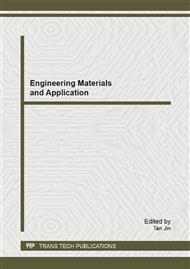[1]
Krasner, W. S., Weinberg, S. H., Richardson, D. S., Pastor, J. S., Chinn, R., Sclimenti, J. M., Onstad, D. G., Thruston, D. A., Occurrence of a New Generation of Disinfection Byproducts, Environ Sci and Technol. 40 (2006) 7175-7185.
DOI: 10.1021/es060353j
Google Scholar
[2]
Chen, H. S., Ding, Y. L., Lapkin, A., Fan, X. L., Rheological behaviour of ethylene glycol-titanate nanotube nanofluid, J Nanopart Res. 11(2009) 1513-1520.
DOI: 10.1007/s11051-009-9599-9
Google Scholar
[3]
Ding, Y. L., Alias, H., Wen, D. S., Williams, R. A., Heat transfer of aqueous suspensions of carbon nanotubes (CNT nanofluids). Int J Heat Mass Transfer. 49(2006) 240-250.
DOI: 10.1016/j.ijheatmasstransfer.2005.07.009
Google Scholar
[4]
Demming, A., Big challenges and nanosolutions. Nanotechnology. 22(2011) 290201-290201.
DOI: 10.1088/0957-4484/22/29/290201
Google Scholar
[5]
Simon-Deckers, A., Loo, S., Mayne-L'Hermite, M., Herlin-Boime, N., Menguy, N., Reynaud, C., Gouget, B., Carriere, M., Size-, Composition- and Shape-Dependent Toxicological Impact of Metal Oxide Nanoparticles and Carbon Nanotubes toward Bacteria. Environ Sci and Technol. 43(2009).
DOI: 10.1021/es9016975
Google Scholar
[6]
Zhang, L. L., Jiang, Y. H., Ding, Y. L., Povey, M., York, D., Investigation into the antibacterial behaviour of suspensions of ZnO nanoparticles (ZnO nanofluids). J Nanopart Res. 9(2007) 479-489.
DOI: 10.1007/s11051-006-9150-1
Google Scholar
[7]
Zhang, L., Ding, Y., Povey, M., York, D., ZnO nanofluids - A potential antibacterial agent. Prog Nat Sci. 18(2008) 939-944.
DOI: 10.1016/j.pnsc.2008.01.026
Google Scholar
[8]
Lydakis-Simantiris, N., Riga, D., Katsivela, E., Mantzavinos, D., Xekoukoulotakis, N. P., Disinfection of spring water and secondary treated municipal wastewater by TiO2 photocatalysis. Desalination. 250 (2010) 351-355.
DOI: 10.1016/j.desal.2009.09.055
Google Scholar
[9]
Andre, V. and R.W. Brotzman, Korea Patent KR20070001262. (2007).
Google Scholar
[10]
Zhang, L. L., Jiang, Y. H., Ding, Y. L., Daskalakis, N., Jeuken, L., Povey, M., O'Neill, A.J., York, D.W., Mechanistic investigation into antibacterial behaviour of suspensions of ZnO nanoparticles against E. coli. J Nanopart Res. 12(2010).
DOI: 10.1007/s11051-009-9711-1
Google Scholar


